Private Schools Offer Options for Students
| 2015 Q2 | story by TARA TRENARY | photos by STEVEN HERTZOG |
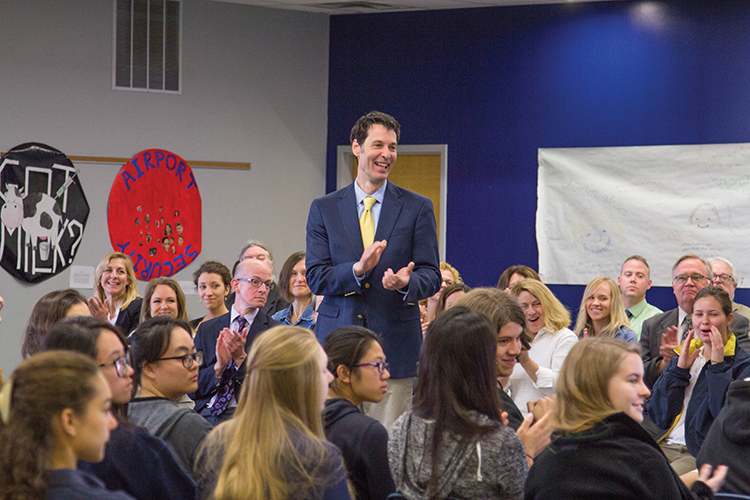
Don Schawang, Bishop Seabury Academy Head of School addressing students and staff
With the challenges we face in the world today, providing our kids with the best education possible has become paramount. Though cliché, it has never been truer: Our children are our future.
Lawrence parents have many varied options when it comes to choosing a school for their children. Though many will automatically go the public-school route for various reasons, including good local public schools, private-school options are there to be explored. Because parents want the best when it comes to their children, a private-school education might be the best choice for your family.
Educators agree that parents need options when it comes to choosing the right schools for their kids. Most importantly, they need to explore and be educated about those options.
“When students feel more comfortable, they’re going to be more academically successful,” says Don Schawang, Bishop Seabury Academy Head of School. “Education is so important. Every parent has a right to look at what environment is best for their kids.”
Luckily for this community, options are not few and far between. And each private school here has a very different approach, a good thing for those parents who are unsure exactly what will work best for their children. Following is a look at some private schools in Lawrence and what they have to offer your child.
Bishop Seabury Academy
Bishop Seabury Academy was founded in 1990 by a group of parents interested in forming an independent high school in Lawrence. It is a nonprofit organization financed by student tuition and a member of the Independent Schools Association of the Central States (ISACS), which provides accreditation, professional development and support services to its member schools throughout the Midwest. Though the school’s board does not run the school, it does hire and fire the head of school, set goals for the school and look after its fiscal workings.
To be selected as a teacher at Bishop Seabury, candidates are required to have undergraduate degrees, and Schawang prefers an additional degree in their specified field of expertise. Students must fill out an application, provide transcripts and complete an interview, and their grades must be up to par to be accepted.
“It’s a matter of the right fit,” Schawang says.
Tuition assistance is provided through the FAST program, which recommends awards for families based on certain financial criteria.
The school, grades six through 12, operates under two hemispheres, academic and character development, both of which are equally important.
“We specifically are a college-preparatory school,” Schawang says. “Our school is for students who love to learn. The academic achievement is very strong.”
At Bishop Seabury, it is understood that students are planning to attend a four-year college after graduating. With this in mind, the school offers a core curriculum required for college admission and academic success at the college level. It also offers “Honors” classes to junior and seniors who want to distinguish themselves academically.
“We are not populated by geniuses but are for a range of motivated students who want to be challenged,” Schawang explains.
Focusing on character development is another aspect of Bishop Seabury that contributes to its success.
“You’ve got to have the individual respecting and supporting the community,” Schawang says.
This development starts with the school’s focus on student-centered learning. Classes are small with lots of individual attention and have tables, not desks, to promote healthy discussion. The school holds “Morning Meetings” every day, during which students are able to chat with a staff adviser and other students on life topics of their choice. Students are also required to change lunch seating every couple of weeks to encourage social interaction.
“We try to create an environment where everybody knows everybody else,” Schawang says. “It inspires more thoughtfulness.”
Students must get involved in two seasons of nonacademic activities, with sports and theater being strongly encouraged, as well as serve community-service hours through the school’s Community Service Program. Middle school students must serve 20 hours; high school students must serve 30 hours plus complete a service project of their choice.
Overall, Schawang says Bishop Seabury’s goal is to help its students become the very best they can be as young adults contributing to society.
“When you come into the school, you can feel something different here. Students are happy and respected; teachers care. This is a place where it’s cool to be smart,” Schawang says.
Century School
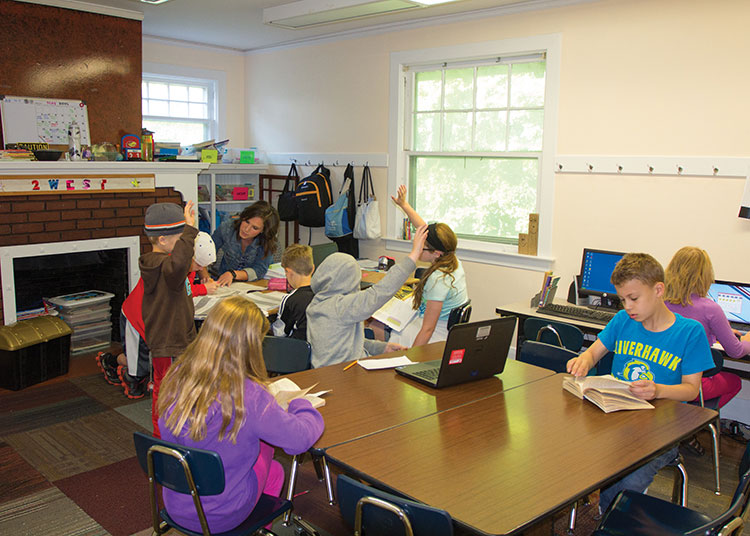
Century School classroom
Century School is a nonprofit organization founded in 1994 by a former KU professor of applied behavior science as an alternative to public school. This year-round school for ages three through 12, financed by student tuition, is dedicated to the requirements of modern families. Parents can schedule their own arrival and departure times, as well as attendance, eliminating the need for before- or after-school care. The school is located in a house so students feel like they are at home, and it’s in the heart of downtown Lawrence so they can learn what it’s like to be part of the community as a whole and get involved as much as possible.
Classes at Century School are mixed-age with no more than 12 students and one teacher per class, making it ideal for personalized attention from teachers. Because of this individualized approach, teachers are able to address each student’s needs and behaviors proactively.
“It’s a truly efficient model,” says Jon Stutler, Century School’s Principal Teacher.
From its inception, Century School is rooted in behavior analysis and focuses on encouraging kids to practice helpful behaviors through positive reinforcement. Teachers, to address each individual child’s needs, are constantly evaluating the social, physical and emotional aspects of students and their education.
“You can’t think of kids as a group; they are an entity of one,” Stutler explains.
This “entity of one” concept is evident in the school’s approach to education. The self-paced atmosphere balances its mixed-age classes with younger students learning from older students’ examples. Teachers are the “world’s best cheerleaders” for their students and emphasize making good choices in all areas, such as friendship, citizenship and academics. And everything at Century School is taught to mastery.
“Our school is an example of a really positive, attractive community of teachers and students all pulling in the same direction,” Stutler says. “It’s not just one thing that makes us unique; it’s that so many of these things have been thought out and improved upon.”
At Century School, the relaxed, competition-free environment is a haven for students who benefit from a more one-on-one approach and teachers who enjoy the freedom of working very closely with each and every one of their students.
“More than anything, our parents have access to the teachers, who ultimately give them the confidence that their kids are in the right hands,” Stutler says.
Corpus Christi Catholic School

New media center at Corpus Christi Catholic School
What began as Lawrence Catholic School in 1997 in response to growing demand for Catholic education in the community, Corpus Christi Catholic School is a unified school system owned and operated by the Archdiocese of Kansas City in Kansas, and financed by the parish. However, those who are not members of the parish pay yearly tuition. The school promoted its first class in the spring of 2007. In August 2011, its first school year began with grades six, seven and eight, aligning Corpus Christi with the most traditional Catholic schools in its archdiocese. Today, it is a preschool through eighth-grade school.
Accredited through AdvancED, Corpus Christi’s curriculum meets the requirements of the State of Kansas, the Archdiocese of Kansas City in Kansas and the North Central Association for Accreditation. Students take State of Kansas standardized tests, among others, and teachers must be licensed through the state and certified through the Archdiocese of Kansas City in Kansas.
Corpus Christi aims to be a “home away from home” for its students, Corpus Christi Principal Mary Mattern says, with Christ-centered classes on the smaller side, each averaging 17 students and one teacher. To make sure students get the education they and their parents expect, teachers look at students individually and put a learning plan together for them that will keep them steadily moving forward. They know each child personally and have been “taught to teach to every student.”
“We expect a lot out of the kids,” Mattern explains. Infusing the Catholic piece into the curriculum is one of the things that sets Corpus Christi apart from the rest.
Students at Corpus Christi are also very involved in giving back to the community. From donating to the homeless shelter and the humane society, to participating in Just Food and Habitat for Humanity, to collecting coats for area Native American reservations, Corpus Christi is “constantly, as a school, challenging ourselves to make a difference,” Mattern explains.
Technology and the arts are also a large focus at Corpus Christi. A new multimedia center, built large enough so multiple classes can use it simultaneously, keeps the school ahead of the game.
“This multimedia center is worth its weight in gold, as scheduling of classes both on the master schedule as well as individual teachers’ lesson plans is much easier,” Mattern says.
High tech doesn’t stop there: Each middle school student is given a MacBook Air for use at school, and each classroom is equipped with a minimum of four laptops as well as a Polyvision ENO board.
“It’s not just the numbers here,” Mattern concludes. “It’s truly about the child and what we can do for them.”
Prairie Moon Waldorf School

Prairie Moon
The only Waldorf school in Kansas to date, Prairie Moon School opened in Lawrence in 2004 to provide its students with a multisensory approach to education, blending artistic, practical and academic work. In 2007, it earned the right to use “Waldorf” in its name after being designated a developing Waldorf school by the Association of Waldorf Schools of North America (AWSNA). Prairie Moon meets AWSNA and Waldorf Early Childhood Association of North America (WECAN) standards. This preschool through eighth-grade school also offers a tuition-assistance program.
Getting Waldorf-trained teachers in Kansas can be difficult, so the school also hires teachers with a bachelor’s degree and a commitment to work toward a Waldorf Teaching Certificate. To further support their training, the school brings in teacher trainers and hosts multiple training opportunities per year for its own faculty and faculty visiting from other schools across the country. Teachers also work with mentors (Master Teachers) from other Waldorf schools to hone their Waldorf skills.
A Waldorf education strives to mold students into creative, motivated, confident adults by educating the “whole” child and providing an enlivened education. It emphasizes developing its students’ intellectual, physical and social skills while also recognizing their spiritual nature.
“How we teach is different,” says Melissa Watson, Prairie Moon Administrator. “The data isn’t important, it’s how [students]learn. How connected they stay to the act of learning is very important.”
Prairie Moon’s nurturing, homelike environment fosters an academic, artistic and practical education for its students. An importance is also placed on honoring spirit, cultivating freedom and fostering harmony with the natural world. The school aims to “remove the anxiety and fears around academics” in their students, Watson says. It also tries to keep students at their appropriate age and protect their development as a child.
“We’re really looking at what’s appropriate for the child at each age level.”
Prairie Moon teachers work to foster their students’ natural love of learning using music, art, movement and song to bring their lessons to life. They stay with their students from first grade, learning each child’s personality and needs intimately, and developing a relationship in which the teacher guides the student in an exploration of their world. Traditional textbooks are not used at Prairie Moon; students create their own textbooks while interacting with their teachers during lessons.
“For a student to develop a lifelong love of learning, that student must understand how it is they learn best,” Watson explains. “[Our students] education runs deep. How much a child holds onto is directly related to how much they loved it when they were learning it.”
Raintree Montessori School
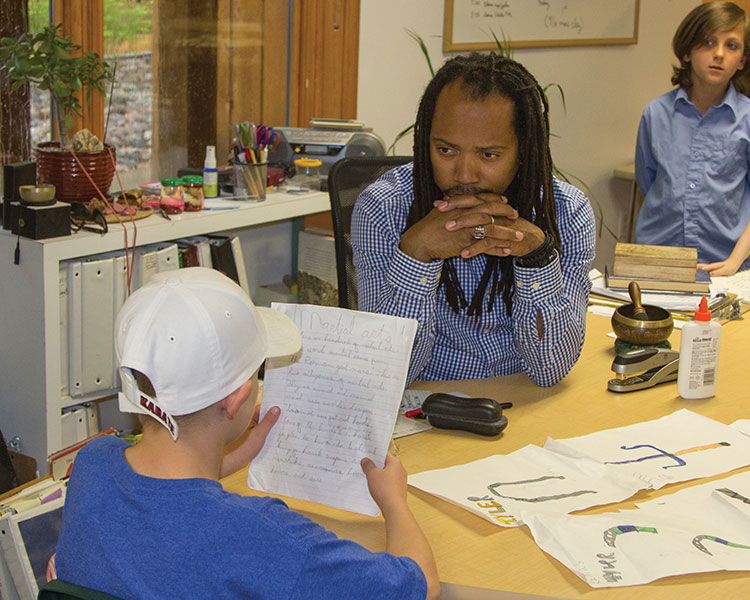
Joe Sears works with student
Raintree Montessori School was founded in 1978 by a small group of people with a vision for a beautiful place lovingly and intentionally prepared for children. Its founders saw a need in the Lawrence community for an optimum, all-day learning environment for kids with working parents. It is a member of the North American Montessori Teachers’ Association (NAMTA), the Association of Montessori Internationale (AMI) and the American Montessori Society (AMS), which means it must follow the tenets of all of these associations. Its teachers, called guides, are required to have a bachelor’s degree and at least an AMI or AMS certification.
“Maria Montessori’s work continues to be validated by current research,” says Lleanna McReynolds, Head of School at Raintree, a toddler (age 18 months) through adolescent (14 years old) school. “She was one of the first to design and use concrete learning materials, and just this year, a research study validated the importance of cursive handwriting, something Montessori students learn from the moment they enter Raintree.”
Raintree follows a “triangle” model: teacher, child and environment. It places a heavy emphasis on emotional development, with teachers staying with their students for three years. The mixed-age classrooms are like families, working communities whose members care for one another.
The school uses multisensory instruction, where children get lessons on an array of subjects at more and more advanced levels. Toddler and preschool classes offer one-on-one instruction, while elementary and adolescent classes are done in seminars. Students develop their own textbooks, and teachers have the freedom to adapt the environment and tailor lessons to meet the specific needs of students. Everything is laid out and available at all times, and students work at their own pace. There is also a focus on “lessons of grace and courtesy.”
“What we are after is creating a working environment which allows the child to concentrate,” McReynolds explains. “The children have a choice, but within guidelines. Freedom, but with responsibility.”
One of the most important aspects of Raintree, McReynolds says, is the study of peace. Maria Montessori, founder of the Montessori school, was a nominee for the Nobel Peace Prize three times, seeking a peaceful world through her work with children across the world.
“From the moment children enter the school, they are encouraged to help each other,” McReynolds explains. “Tying a classmate’s apron, learning how to serve a guest or hosting a bake sale for others in need are simple yet profound gestures, all in preparation for life beyond the walls of our school. Just as Montessori envisioned: education for peace.”
St. John Catholic School
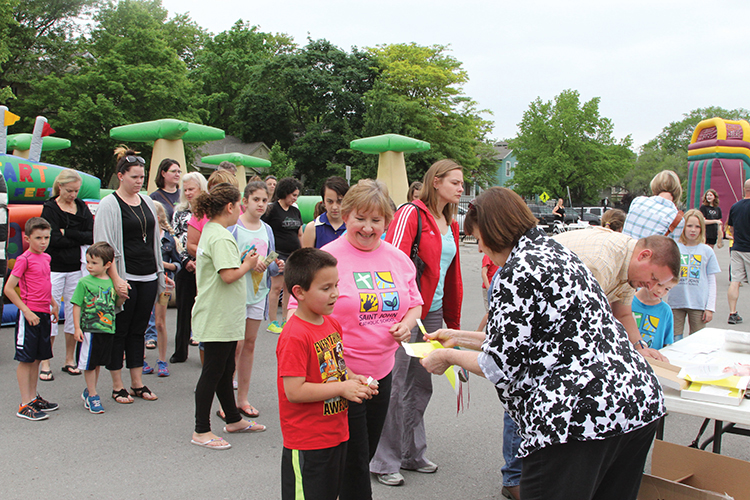
St. John Principal, Pat Newton makes her rounds at the St. John Carnival.
The first Catholic elementary school in Lawrence, St. John Catholic School opened in 1956 as a parish school for children attending the church. Many years passed, and multiple changes ensued in the school and the community’s need for Catholic education. St. John and Corpus Christi parishes merged, and The Lawrence Catholic School was developed. Years later, the parishes split, and two schools were formed, St. John and Corpus Christi. In 2007, St. John developed a preschool, and Spanish language was added to the curriculum. In 2011, middle school grades were added, making St. John the kindergarten through eighth-grade school it is today.
St. John is certified by the State of Kansas and accredited by AdvancED and the North Central Association of Colleges and Schools. It is owned and operated by the Archdiocese of Kansas City in Kansas, and financed by the parish. However, those who are not members of the parish pay yearly tuition. Administrators attempt to hire only Catholic teachers, who must have a bachelor’s degree and, preferably, a master’s degree in their field of study.
“We really keep an eye on our community,” says Pat Newton, St. John’s Principal. “We are very Lawrence.”
She says many of their students are children of University of Kansas faculty members, who support the school’s values and goals—spiritual, academic, behavioral and environmental. St. John is also a Kansas “Green” School. It won a Green School Award in 2013, meaning it puts a huge emphasis on the environment and “anything God made.”
St. John’s instruction style focuses more on main line academics—science, math, literature, arts, physical education and health. It takes the Common Core guidelines and infuses the Catholic faith.
“The challenge is to keep all those areas in the forefront and not drop them,” Newton says. “There’s a spiritual slant to the Common Core.”
The flexibility of being a private school is also a very important aspect of St. John School. Class sizes are small, no more than 15 students per class. Teachers meet regularly to look at their students’ skills and levels, and are able to adjust the curriculum, if necessary. And they work closely with parents to make sure their students’ needs are being met.
“The glory of a private school is that we can turn on a dime,” Newton says.
Ultimately, “We just want kids to be happy and successful, to feel good about themselves,” Newton explains. “If you’ve got that in place, everything else follows.”
Veritas Christian School
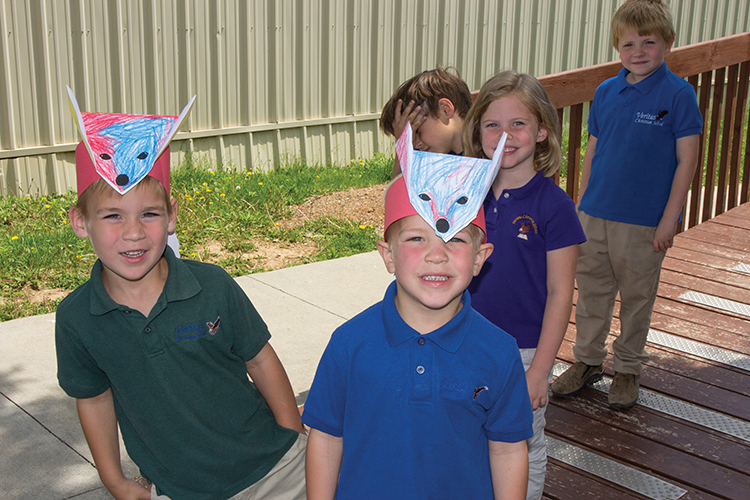
Veritas Chistian School students
Originally named Douglas County Christian School, Veritas Christian School opened in 1978 with the belief that a Classical Christian Education gives students the best opportunity to succeed academically. In 2004, it became a kindergarten through 12th grade school, offering a complete educational process to its students. It is financed by student tuition and has a scholarship program to help families in need. The school’s No. 1 goal is to help students develop a personal relationship with Jesus Christ.
Veritas is a member of the Association of Classical and Christian Schools (ACCS) and the Association of Christian Schools International (ACSI), requiring the school to maintain high academic standards, policies and testing. It provides yearly national testing using TerraNova assessments, which are used across the country as benchmarks. Teachers must have a bachelor’s degree in their specific area of study and be licensed through the State of Kansas or certified by ACCS or ACSI.
The ultimate goal is to create lifetime learners long after their academic careers have ended, explains Kelli Huslig, Administrator at Veritas. “[Our students] are ready for whatever is next on their journey.”
Veritas is a Classical Christian School, a form of education aimed at teaching students specific subject matter but also training them to think and learn. It implements the Trivium into its instruction: grammar (elementary), where students learn fundamental data of subjects; logic (middle), where they learn reason, argument and logical thought; and rhetoric (high), where they learn to use intelligent, well-crafted expressions of argument and persuasion.
Class sizes are kept small, to no more than 15 students. And all academics are Christ-centered, with an extensive athletics and fine arts program. High school students have the option of participating in the Dual-Credit Program, earning both high school and college credits. And in order to graduate, seniors are required to complete a “Capstone Project,” which consists of a four-chapter paper on a controversial topic of their choice and a presentation in front of the school community defending their position on the topic.
A student-mentoring program creates camaraderie among all ages. Junior high and high school students are divided into male/female groups that meet weekly to talk about personal topics important to students at that moment. A teacher is also involved.
“We believe in the power of mentoring,” Huslig says. “It is a crucial part going forward with our youth.”
Parent involvement is also crucial at Veritas. It’s not only encouraged but also required.
“Parents know their kids the best and are the best teachers for their kids,” Huslig explains. “It’s a team effort.”
At Veritas, teachers are committed to educating the whole child using a team-driven, Classical Christian approach. A strong family atmosphere adds to the appeal of the school.
“If people want to have a role in their child’s education and desire for them to know Jesus as their personal savior with strong academic standards, this is a good option,” Huslig says. “It’s about what fits the family.”
“The beauty of Lawrence is not only do you have so many private schools, at the same time, you have a really good public school system,” Century School’s Stutler says. “As Lawrencians, we are all very lucky to have options.”

13 Comments
Pingback: Заболевания суставов. MY-DOKTOR.RU – Integra Mais
Thanks again for the blog post.Thanks Again. Much obliged.
You ought to be a part of a contest for one of the greatest sites on the net. I most certainly will recommend this site!
I think that everything posted was very reasonable. However, what about this?
what if you added a little information? I mean,
I don’t want to tell you how to run your blog, but
suppose you added a title to possibly get folk’s attention? I
mean Education With Options: Private Schools is a little
vanilla. You could peek at Yahoo’s home page and watch how
they create news headlines to get viewers to open the links.
You might add a video or a related picture or two to get people excited about what you’ve
got to say. In my opinion, it would bring your website a little livelier.
Look at my web-site – vpn special
Right now it looks like Expression Engine is the best blogging
platform out there right now. (from what I’ve read) Is that
what you’re using on your blog?
Take a look at my homepage: vpn special
There’s definately a lot to learn about this issue. I love all the points you’ve made.
That is a good tip especially to those fresh to the blogosphere. Brief but very precise info… Many thanks for sharing this one. A must read article!
I seriously love your blog.. Pleasant colors & theme. Did you build this amazing site yourself? Please reply back as I’m planning to create my very own site and would love to learn where you got this from or just what the theme is named. Kudos!
Hi, I do think this is an excellent blog. I stumbledupon it 😉 I will revisit once again since I saved as a favorite it. Money and freedom is the greatest way to change, may you be rich and continue to guide other people.
Greate article. Keep writing such kind of info on your page.
Im really impressed by your site.
Hello there, You’ve performed a fantastic job. I’ll definitely digg it
and personally suggest to my friends. I’m confident they will
be benefited from this website.
Your method of explaining all in this piece of writing is genuinely
pleasant, every one can simply be aware of it, Thanks a lot.
Hmm it looks like your website ate my first comment (it was super long) so I
guess I’ll just sum it up what I wrote and say, I’m thoroughly enjoying your
blog. I as well am an aspiring blog blogger but I’m still
new to the whole thing. Do you have any tips and hints for rookie blog writers?
I’d certainly appreciate it.
Here is my page; vpn 2024
Great site you’ve got here.. It�s tough to find good quality writing similar yours nowadays. I honestly appreciate persons similar you! Bear care!!
My web page :: http://Adtgamer.COM.Br/member.php?u=15236